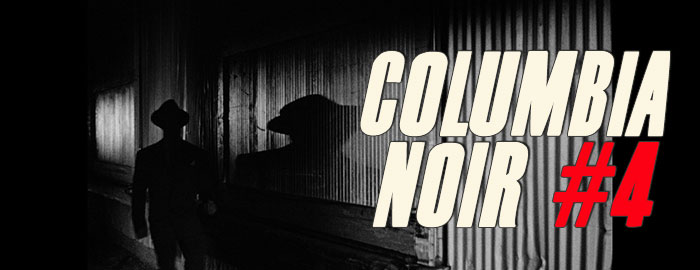

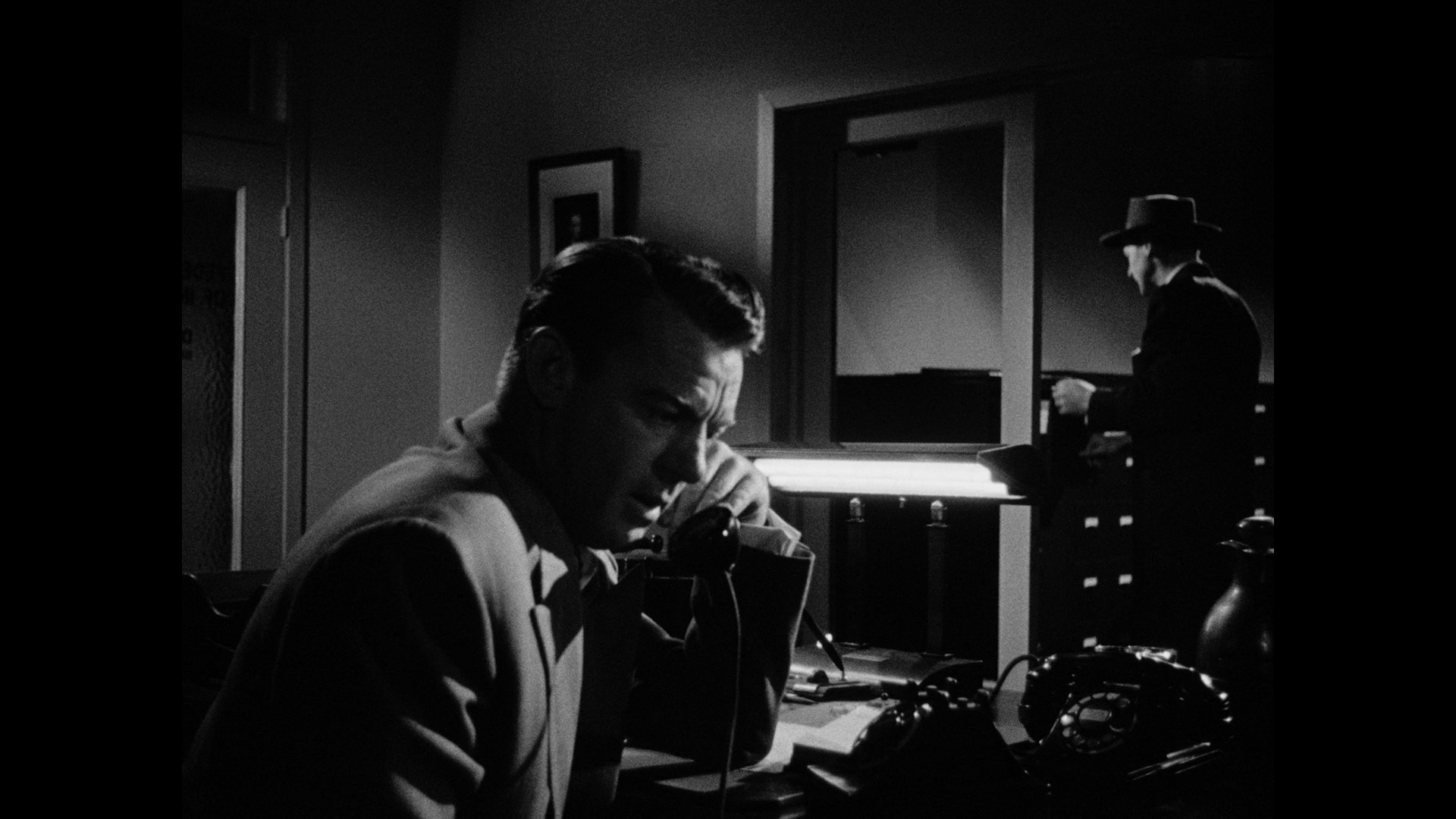 outpouring of postwar film noir (in all its many much-disputed permutations) that started
outpouring of postwar film noir (in all its many much-disputed permutations) that started 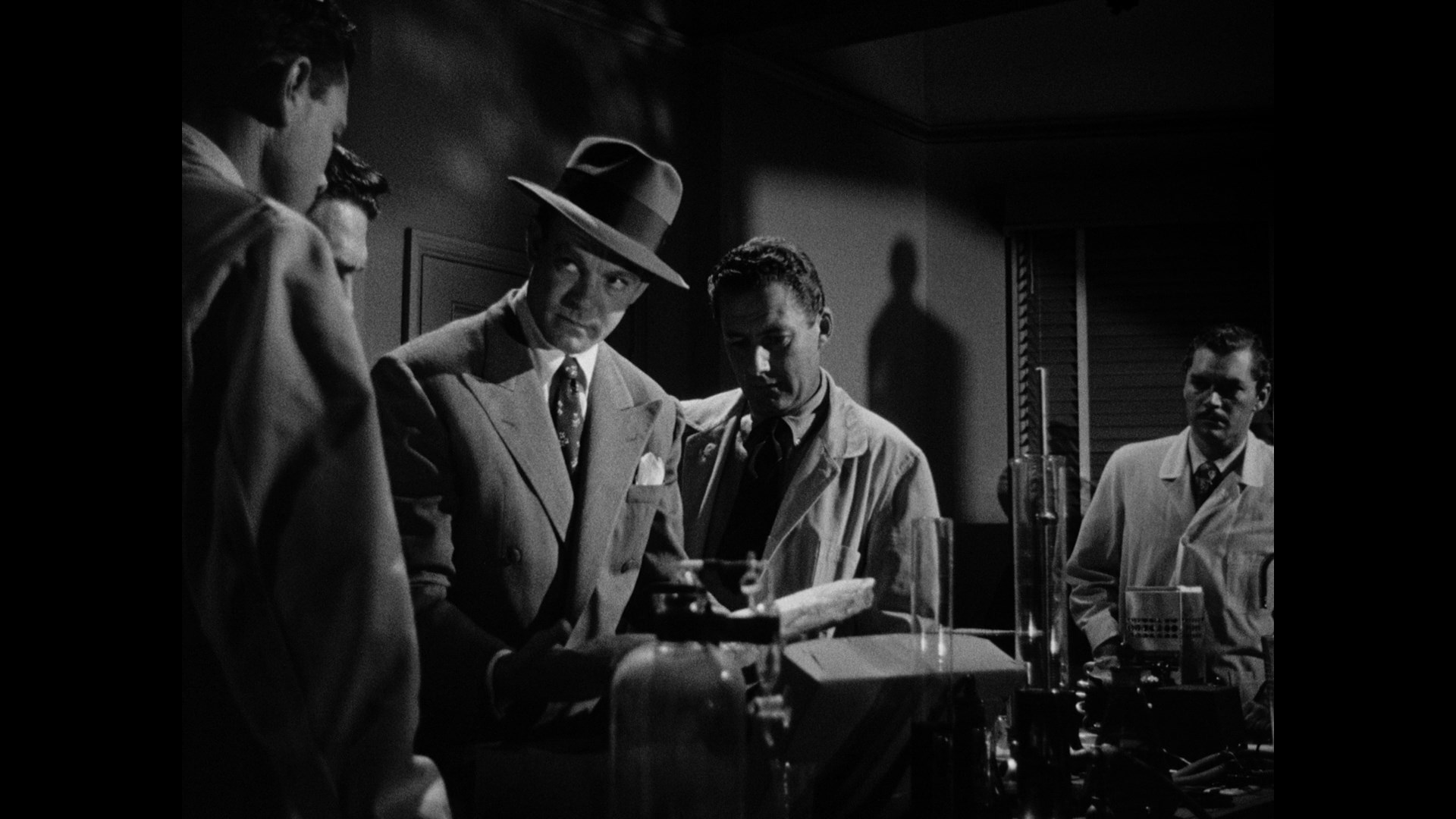 with Columbia Noir #1 and continued with Columbia Noir #2 and Columbia Noir #3, Indicator delivers again with another limited 6,000-unit U.K. set entirely comprised of global Blu-ray premieres. Perhaps more than past sets, this one will cause some debate about what exactly constitutes noir in the first place with some undisputed heavy hitters here mixing with a handful of left-field choices that definitely fall under other genre umbrellas as well.
with Columbia Noir #1 and continued with Columbia Noir #2 and Columbia Noir #3, Indicator delivers again with another limited 6,000-unit U.K. set entirely comprised of global Blu-ray premieres. Perhaps more than past sets, this one will cause some debate about what exactly constitutes noir in the first place with some undisputed heavy hitters here mixing with a handful of left-field choices that definitely fall under other genre umbrellas as well.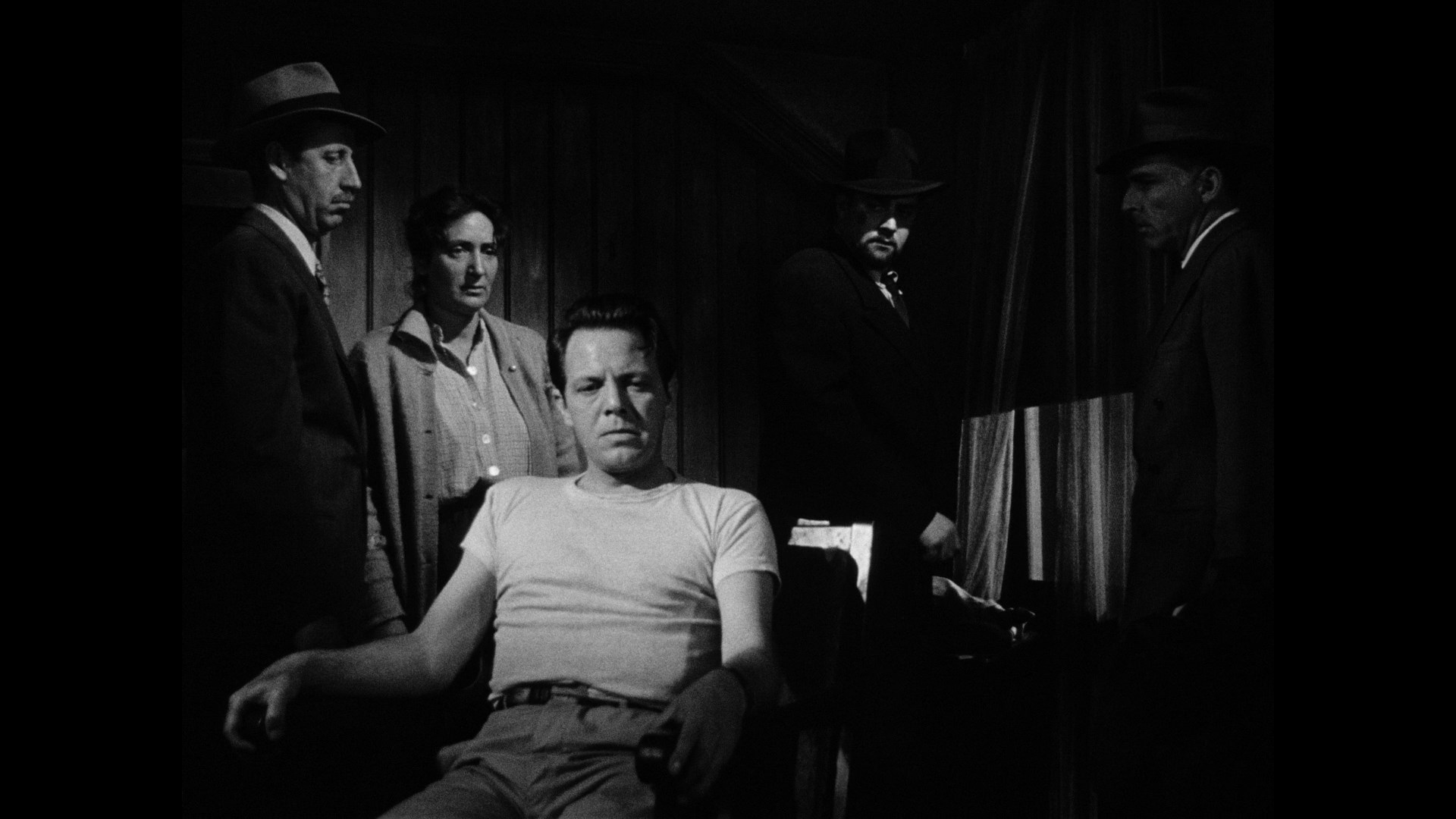 '60s with films like The Detective and the bizarre Skullduggery. It's also quite enjoyable as a look at California culture at the time, including that alternate pronunciation of Los Angeles (with a hard "g") that soon went out of vogue.
'60s with films like The Detective and the bizarre Skullduggery. It's also quite enjoyable as a look at California culture at the time, including that alternate pronunciation of Los Angeles (with a hard "g") that soon went out of vogue. 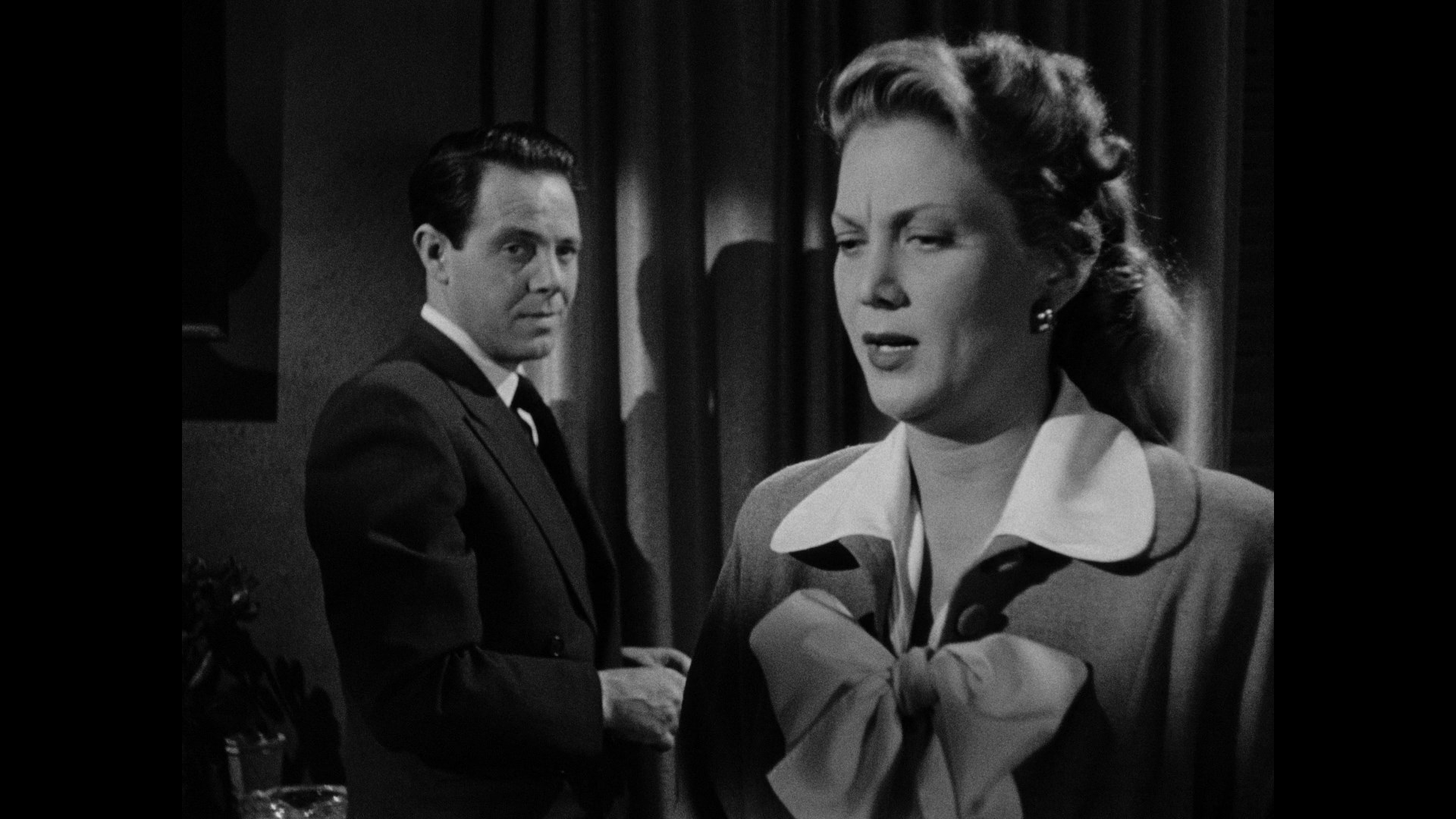 How much this qualifies as a noir is debatable since it feels like more of a straight-up espionage thriller, but the shadowy photography lends enough atmosphere to make it feel at home here anyway.
How much this qualifies as a noir is debatable since it feels like more of a straight-up espionage thriller, but the shadowy photography lends enough atmosphere to make it feel at home here anyway.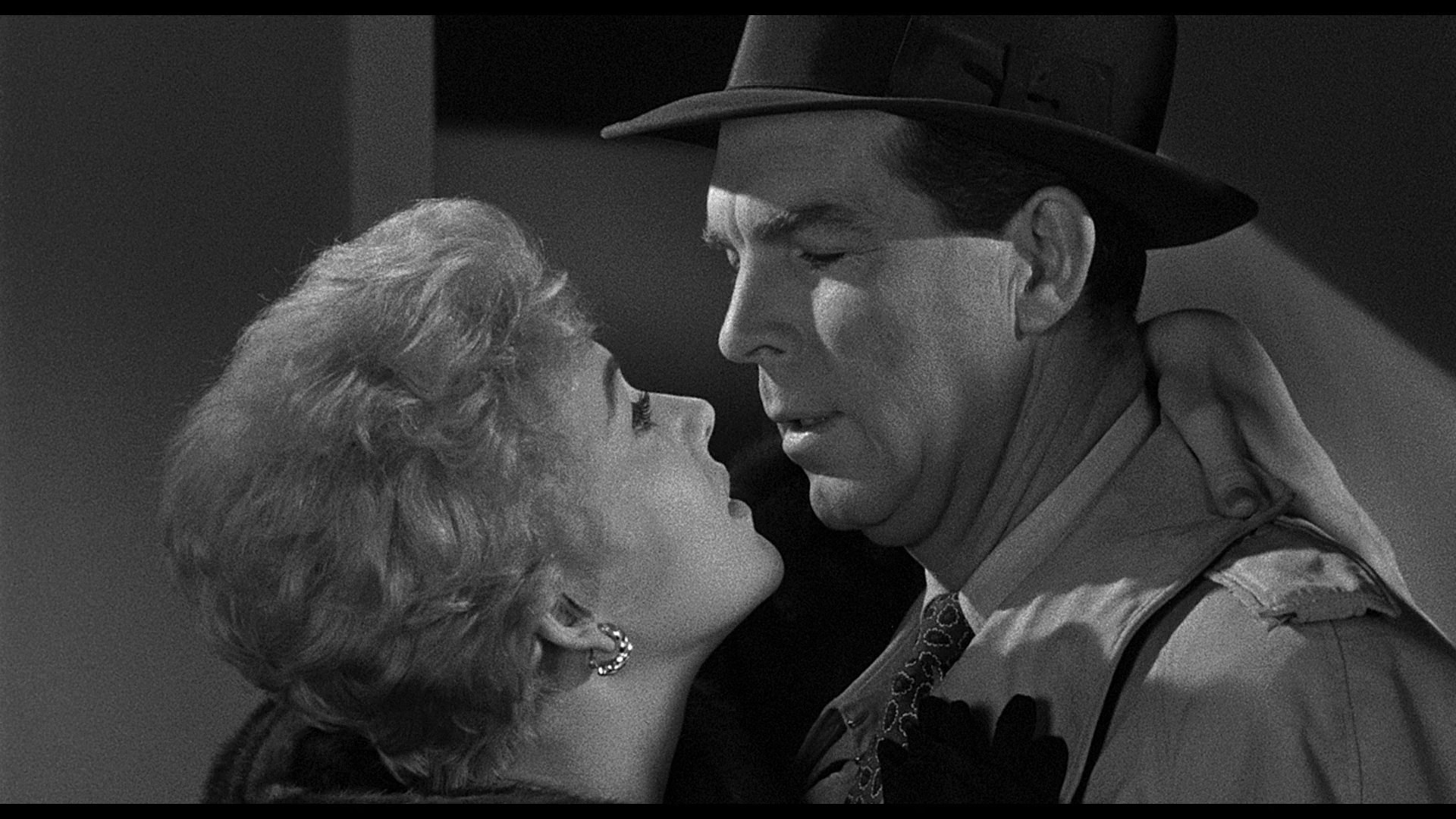 from one of Columbia's most interesting postwar directors,
from one of Columbia's most interesting postwar directors, 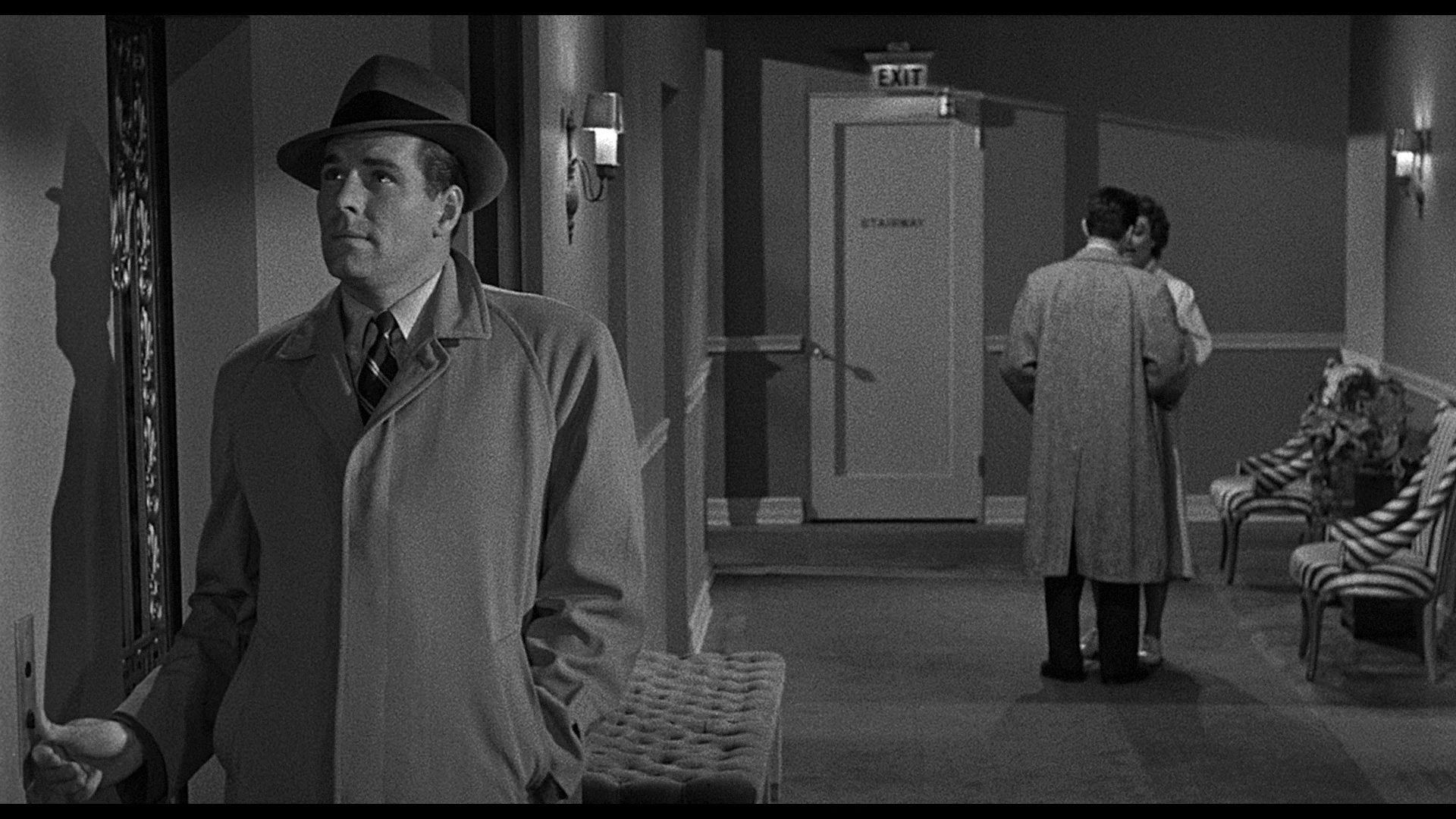 Richard Quine, hot off of the Mickey Rooney noir, Drive a Crooked Road. Kim Novak gets to strut her femme fatale stuff here as Lona, who ends up spending time with cop Paul Wheeler (MacMurray, back to noir after Double Indemnity) when her car stalls. As it turns out, Paul is shadowing her to get the goods on her ex-boyfriend, bank robber Harry Wheeler (Richards), including discovery of the location of the stolen look and identifying his partners. Paul and Lona soon fall for each other, or so it seems, which leads to the hatching of a plot to kill Harry and make off with the stolen cash. Meanwhile innocent nurse Ann (Convicted's Malone, still in her brunette phase) becomes ensnared in the plan while Paul's partner, Rick (Carey), also tries to figure out where the loot is. Getting an "introducing" credit in her first leading role, Novak is really the big attraction her in some fantastic Jean Louis outfits (one of which clearly anticipates Vertigo) and already showing the star power that would make her a Columbia fixture for the next decade (including 5 Against the House).
Richard Quine, hot off of the Mickey Rooney noir, Drive a Crooked Road. Kim Novak gets to strut her femme fatale stuff here as Lona, who ends up spending time with cop Paul Wheeler (MacMurray, back to noir after Double Indemnity) when her car stalls. As it turns out, Paul is shadowing her to get the goods on her ex-boyfriend, bank robber Harry Wheeler (Richards), including discovery of the location of the stolen look and identifying his partners. Paul and Lona soon fall for each other, or so it seems, which leads to the hatching of a plot to kill Harry and make off with the stolen cash. Meanwhile innocent nurse Ann (Convicted's Malone, still in her brunette phase) becomes ensnared in the plan while Paul's partner, Rick (Carey), also tries to figure out where the loot is. Getting an "introducing" credit in her first leading role, Novak is really the big attraction her in some fantastic Jean Louis outfits (one of which clearly anticipates Vertigo) and already showing the star power that would make her a Columbia fixture for the next decade (including 5 Against the House). 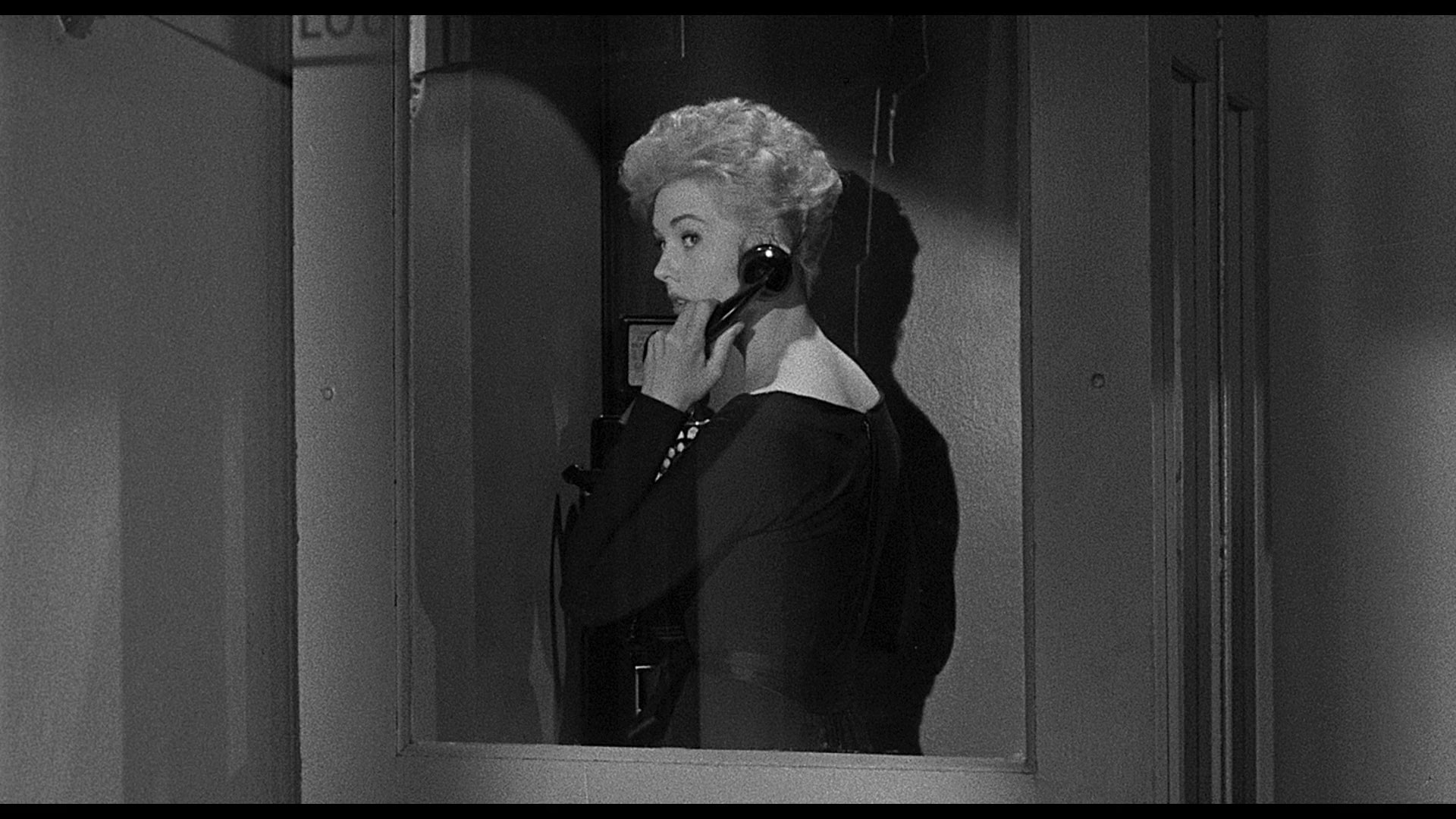 The Brothers Rico, City of Fear, and Nightfall), but it's obviously
The Brothers Rico, City of Fear, and Nightfall), but it's obviously 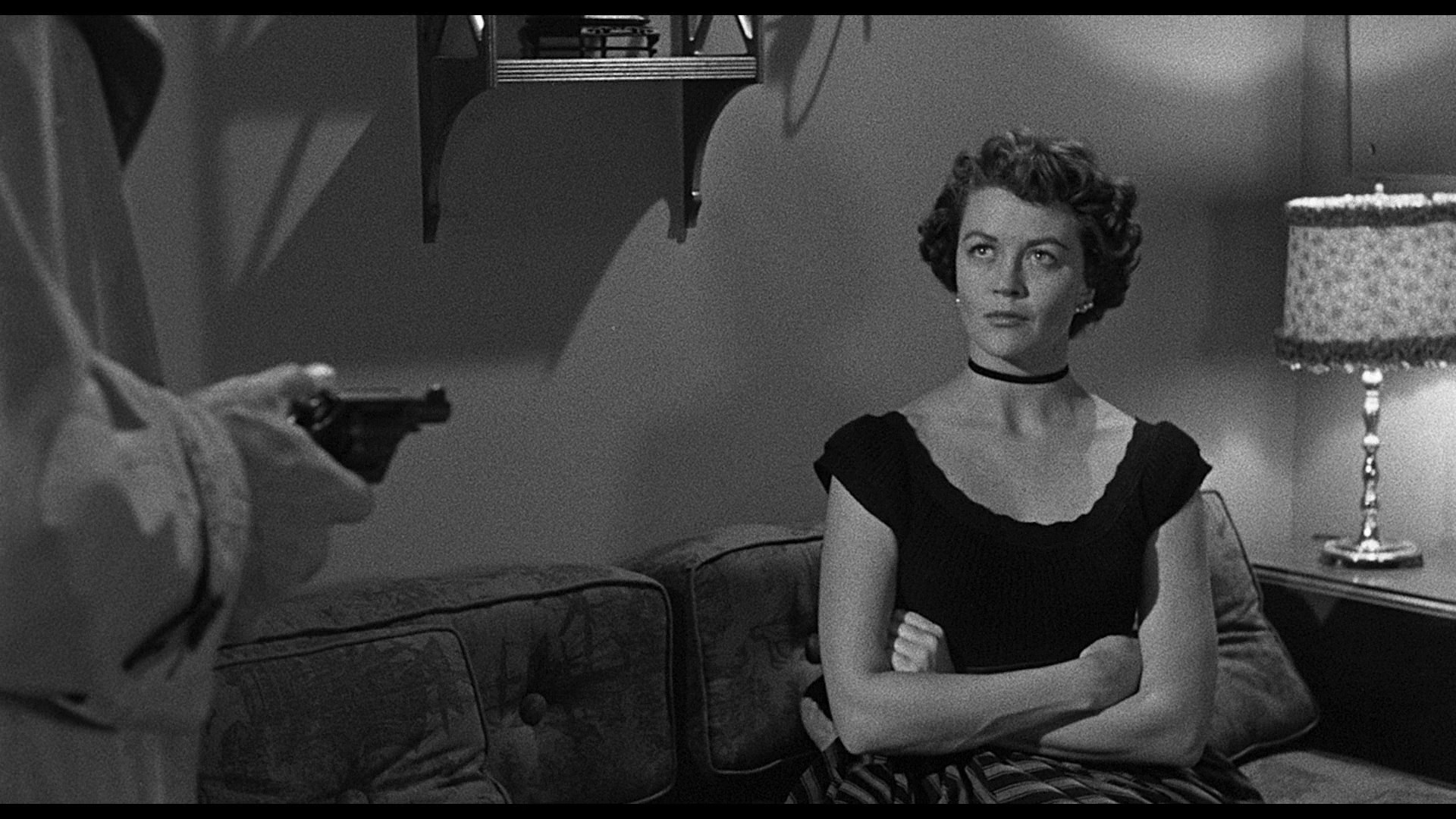 better served here with a nicely appointed Blu-ray that replicates the original photography quite well. Take note that this is a very grainy film for the most part, so anyone averse to the swarming mosquito effect should be aware going in that this is how it's supposed to look. Film historians Alexandra Heller-Nicholas and Josh Nelson provide a new academic audio commentary noting the film's ties to other noirs, the themes of gender relations and spectatorship woven into the story, the use of framing to create a feeling of confinement, and the ambivalence about some of the major characters (especially Rick). In "Partners in Crime and Comedy" (18m19s), critic Glenn Kenny covers the lives and careers of the star and director which including four films together (most famously 1958's Bell Book and Candle) and quite a few odd (and sometimes tragic) developments outside of the studio. Also included are a 30-image gallery, the theatrical trailer (in SD), and the 1955 Three Stooges short Blunder Boys (15m58s), appropriately centered around a bank robbery with the trio as war vets who end up becoming policemen with very iffy professional results.
better served here with a nicely appointed Blu-ray that replicates the original photography quite well. Take note that this is a very grainy film for the most part, so anyone averse to the swarming mosquito effect should be aware going in that this is how it's supposed to look. Film historians Alexandra Heller-Nicholas and Josh Nelson provide a new academic audio commentary noting the film's ties to other noirs, the themes of gender relations and spectatorship woven into the story, the use of framing to create a feeling of confinement, and the ambivalence about some of the major characters (especially Rick). In "Partners in Crime and Comedy" (18m19s), critic Glenn Kenny covers the lives and careers of the star and director which including four films together (most famously 1958's Bell Book and Candle) and quite a few odd (and sometimes tragic) developments outside of the studio. Also included are a 30-image gallery, the theatrical trailer (in SD), and the 1955 Three Stooges short Blunder Boys (15m58s), appropriately centered around a bank robbery with the trio as war vets who end up becoming policemen with very iffy professional results. 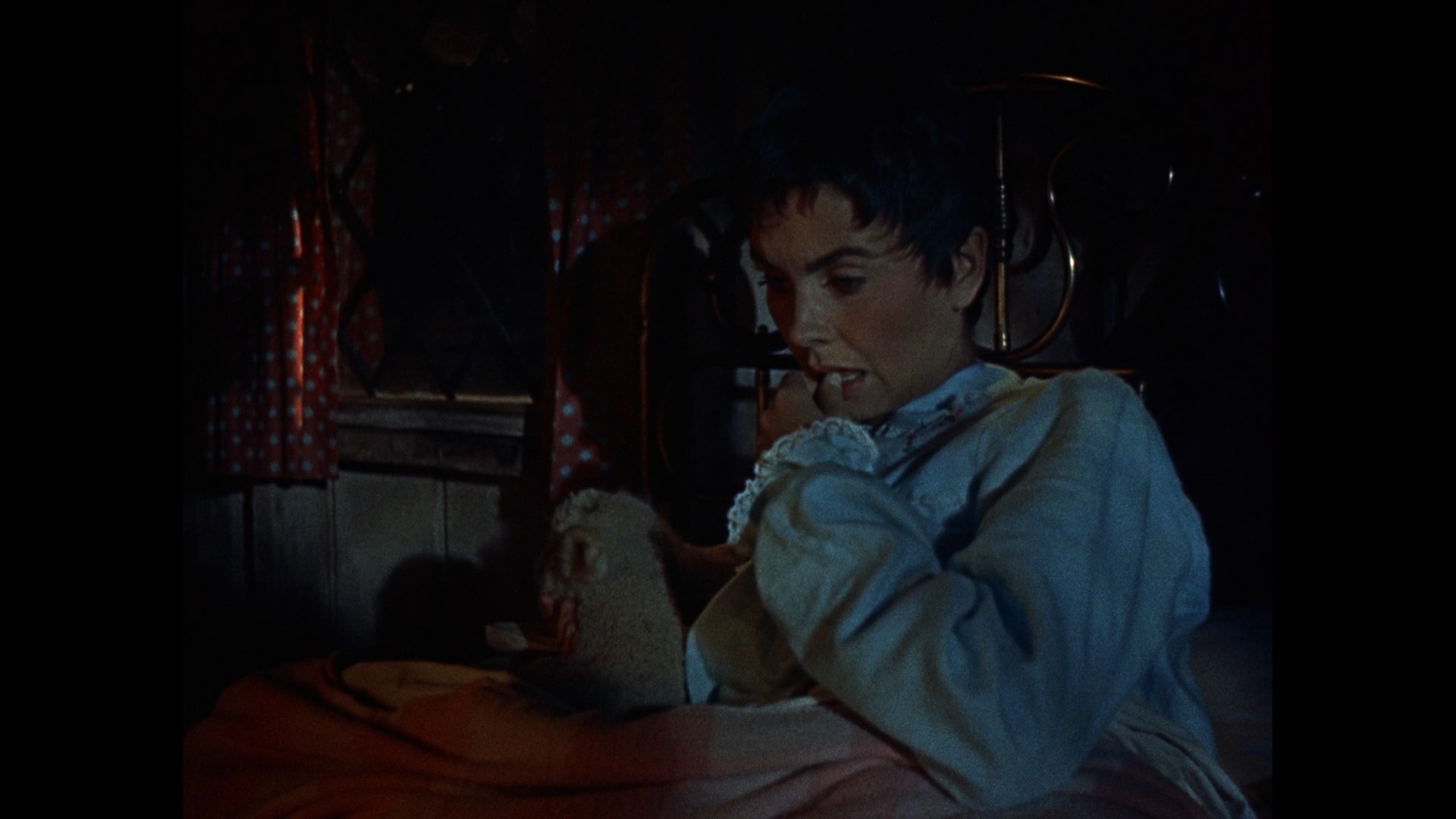 lone color entry and a
lone color entry and a 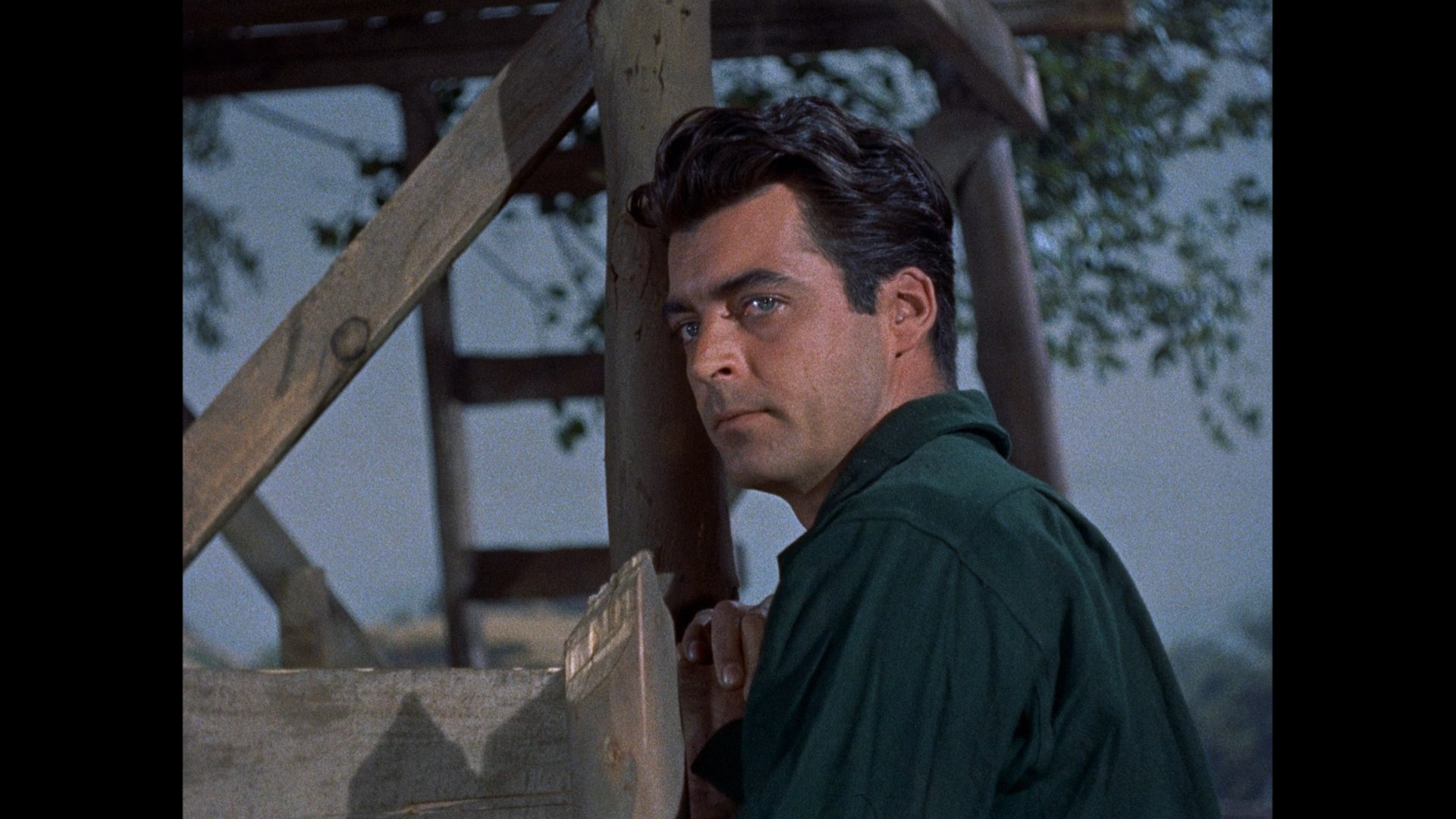 very unusual crime-western-melodrama hybrid (a la Inferno) from director John Farrow (Night Has a Thousand Eyes, The Big Clock). The action starts off right away as we see the aftermath of a plane crash in the desert with footprints being left by the two survivors, convict Ed (Motel Hell's Calhoun) and Frank (McNally), seen tussling together and handcuffed at the wrist. Ed manages to knock out Frank and free himself, stumbling through the dust and finally arriving at a ranch owned by David (Aherne) and his daughter, Cally (Simmons). Cally and Ed start to fall for each other, while Frank explains that he's a lawman who's been on the criminal's trail for two years. Unsure whom she can trust, Cally has to make a difficult decision to determine who's actually telling the truth. Featuring a cast of only four speaking roles (plus a resourceful Collie), this is a lean and effective chamber piece with strong performances and effective use of Technicolor including some blazingly blue skies throughout. The plot is also fun as the audience is left guessing for a good chunk of
very unusual crime-western-melodrama hybrid (a la Inferno) from director John Farrow (Night Has a Thousand Eyes, The Big Clock). The action starts off right away as we see the aftermath of a plane crash in the desert with footprints being left by the two survivors, convict Ed (Motel Hell's Calhoun) and Frank (McNally), seen tussling together and handcuffed at the wrist. Ed manages to knock out Frank and free himself, stumbling through the dust and finally arriving at a ranch owned by David (Aherne) and his daughter, Cally (Simmons). Cally and Ed start to fall for each other, while Frank explains that he's a lawman who's been on the criminal's trail for two years. Unsure whom she can trust, Cally has to make a difficult decision to determine who's actually telling the truth. Featuring a cast of only four speaking roles (plus a resourceful Collie), this is a lean and effective chamber piece with strong performances and effective use of Technicolor including some blazingly blue skies throughout. The plot is also fun as the audience is left guessing for a good chunk of 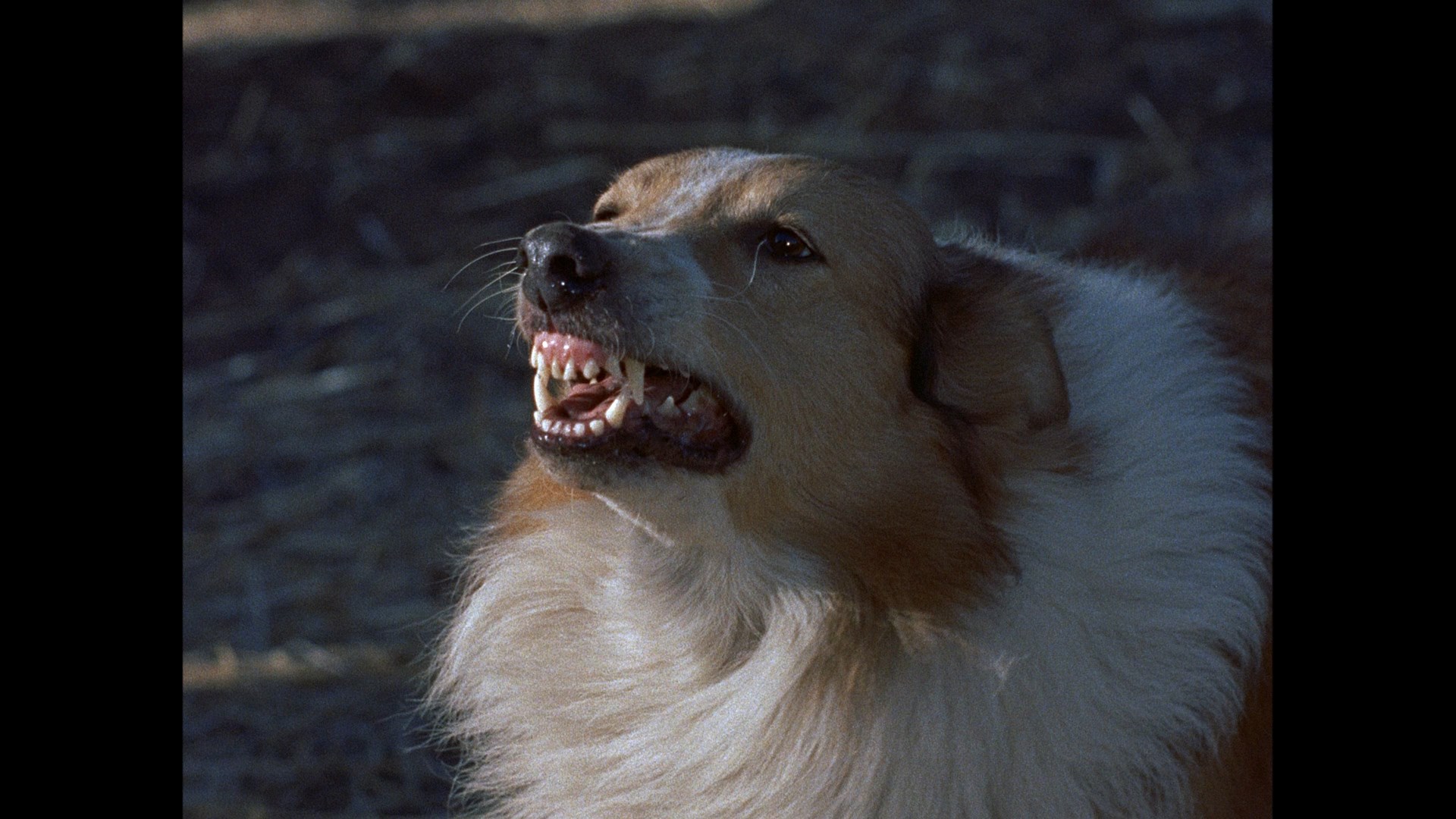 the running time, with (kind of spoiler, perhaps) its
the running time, with (kind of spoiler, perhaps) its 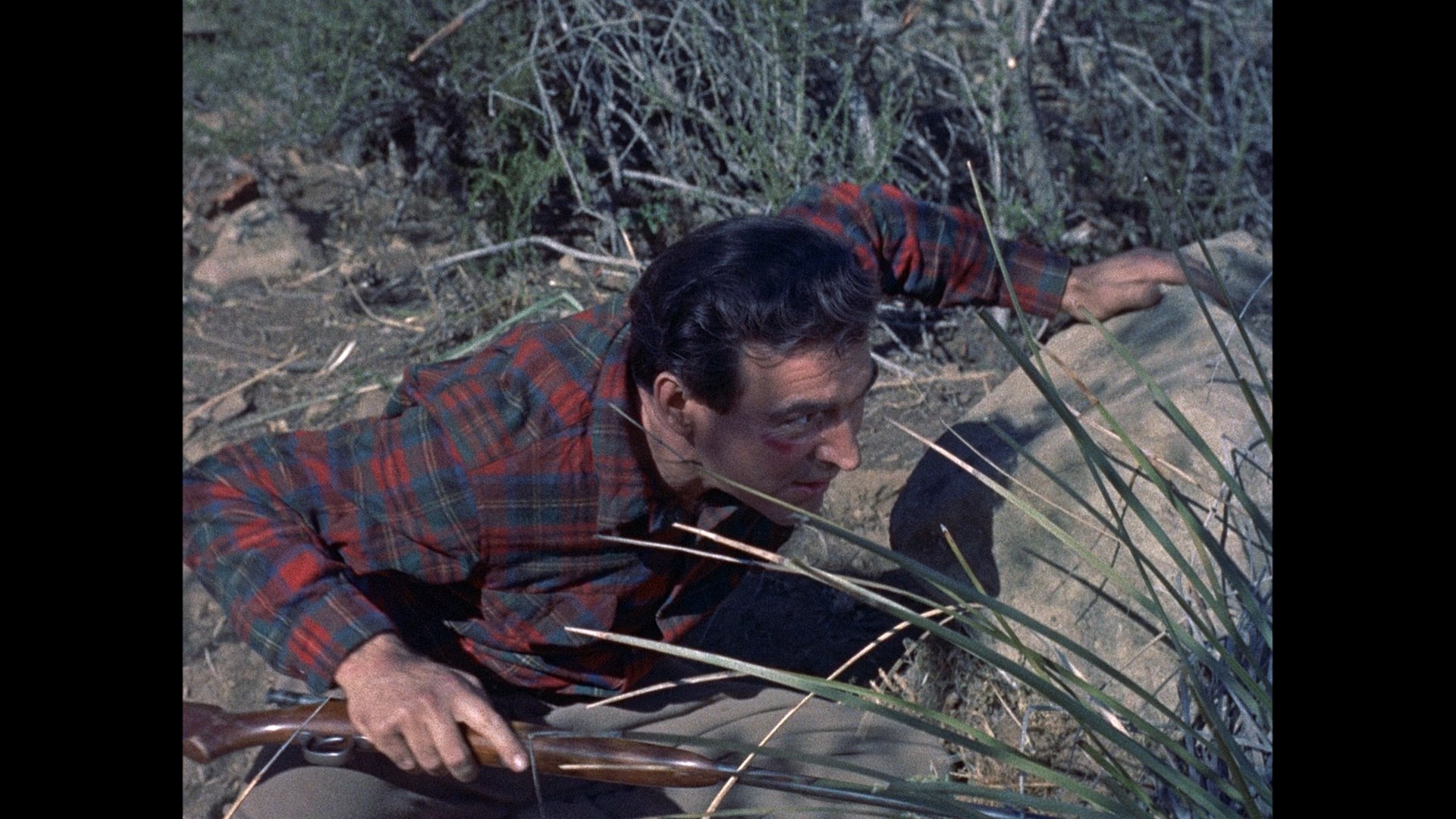 most interesting twist being repurposed later verbatim in 2003's horror film Identity of all places.
most interesting twist being repurposed later verbatim in 2003's horror film Identity of all places.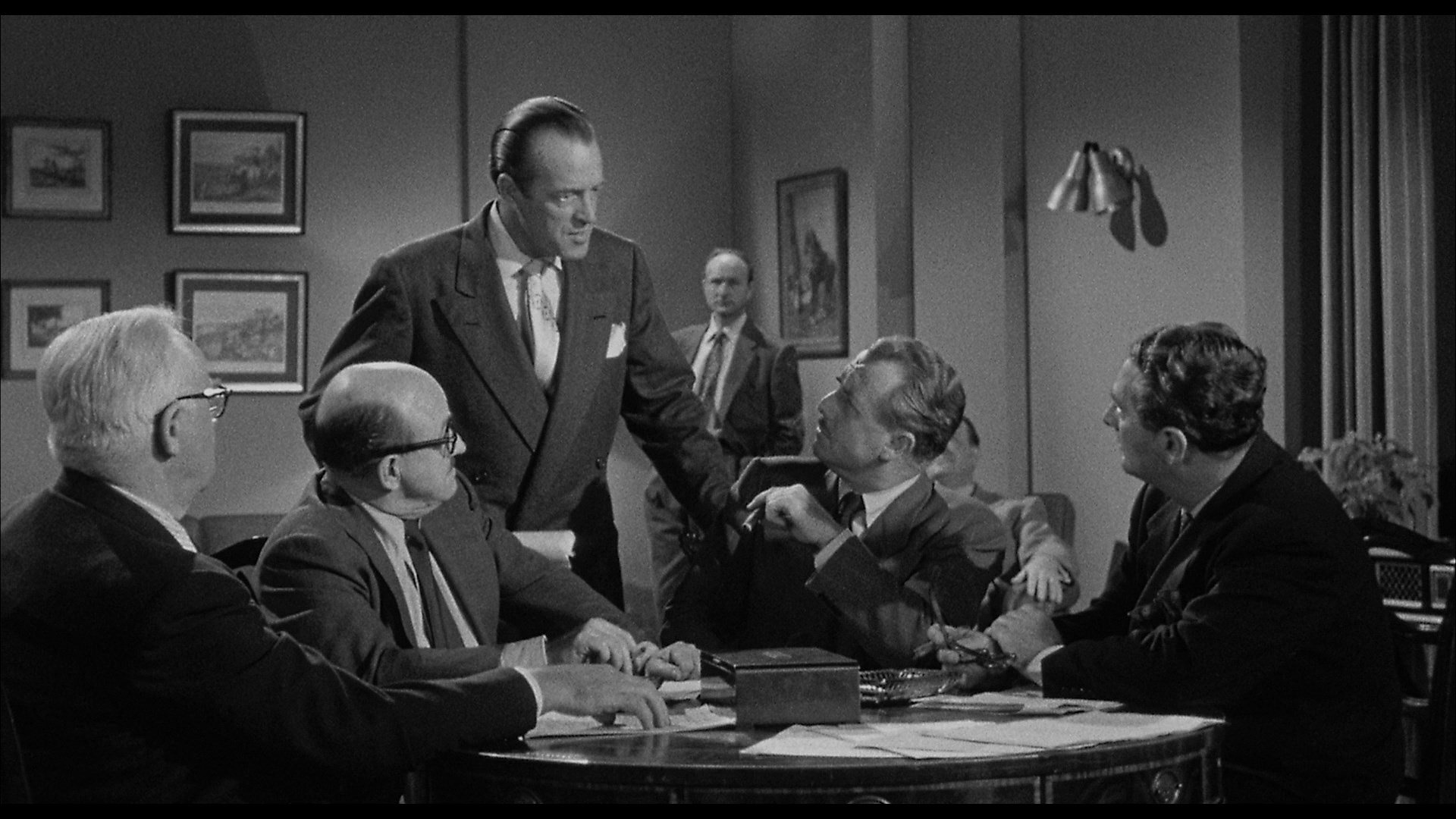 O'Keefe
O'Keefe 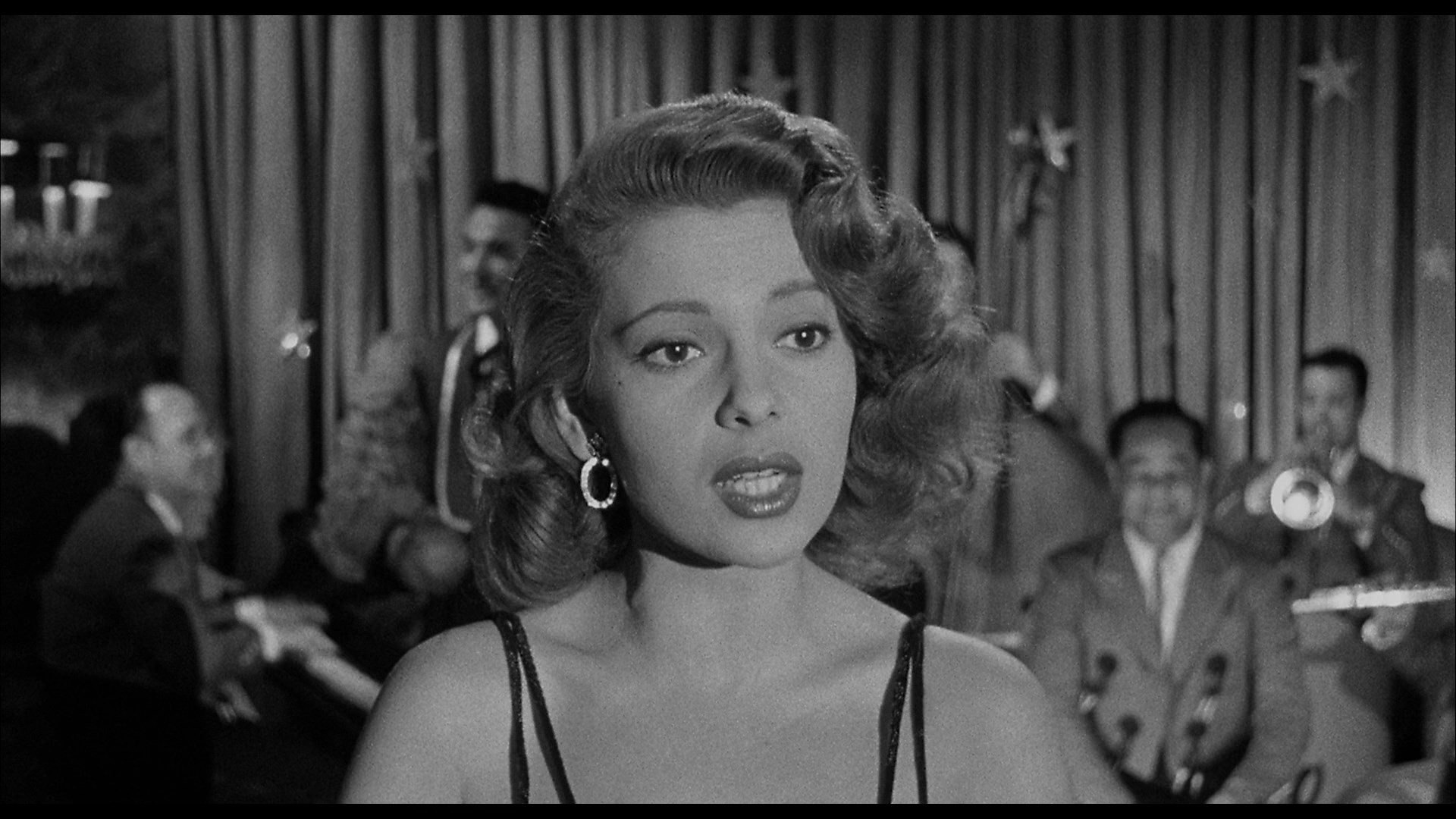 as part of a string of Columbia films (many from producer Sam Katzman) about the criminal underbelly of major American (and Mexican) cities. Now an accountant after serving in WWII, Barry Amsterdam (O'Keefe) is enlisted by a local paper to bluff his way into the graces of criminal insurance scammer and possible murderer Arnold Valent (Stewart) and his associates. Valent takes on Barry, who becomes close to the crook's girlfriend, Connie (Lane), against the backdrop of a swinging nightclub where the performer is none other than the legendary Xavier Cugat and his band. Fairly twisty and fun, this is a lively one from director Fred F. Sears (The Giant Claw) with a compact depiction of how syndicates use legitimate fronts to pull in cash, all set against extensive location footage of the titular city alternating with the usual Hollywood studio material. Cult movie fans will also enjoy a very substantial supporting role here for Allison Hayes, who earned cinematic immortality as the star of Attack of the 50-Foot Woman.
as part of a string of Columbia films (many from producer Sam Katzman) about the criminal underbelly of major American (and Mexican) cities. Now an accountant after serving in WWII, Barry Amsterdam (O'Keefe) is enlisted by a local paper to bluff his way into the graces of criminal insurance scammer and possible murderer Arnold Valent (Stewart) and his associates. Valent takes on Barry, who becomes close to the crook's girlfriend, Connie (Lane), against the backdrop of a swinging nightclub where the performer is none other than the legendary Xavier Cugat and his band. Fairly twisty and fun, this is a lively one from director Fred F. Sears (The Giant Claw) with a compact depiction of how syndicates use legitimate fronts to pull in cash, all set against extensive location footage of the titular city alternating with the usual Hollywood studio material. Cult movie fans will also enjoy a very substantial supporting role here for Allison Hayes, who earned cinematic immortality as the star of Attack of the 50-Foot Woman. 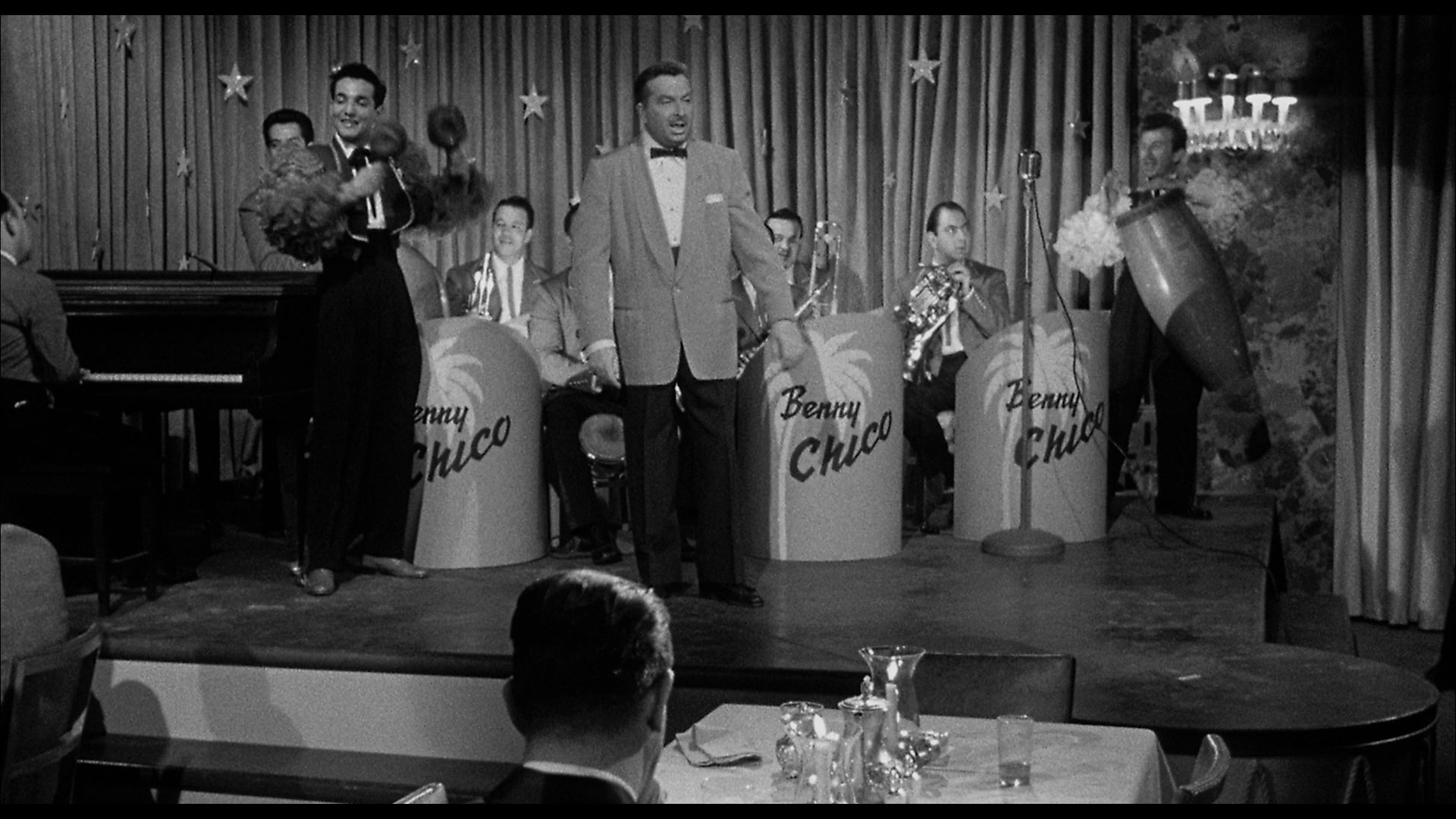 a
a 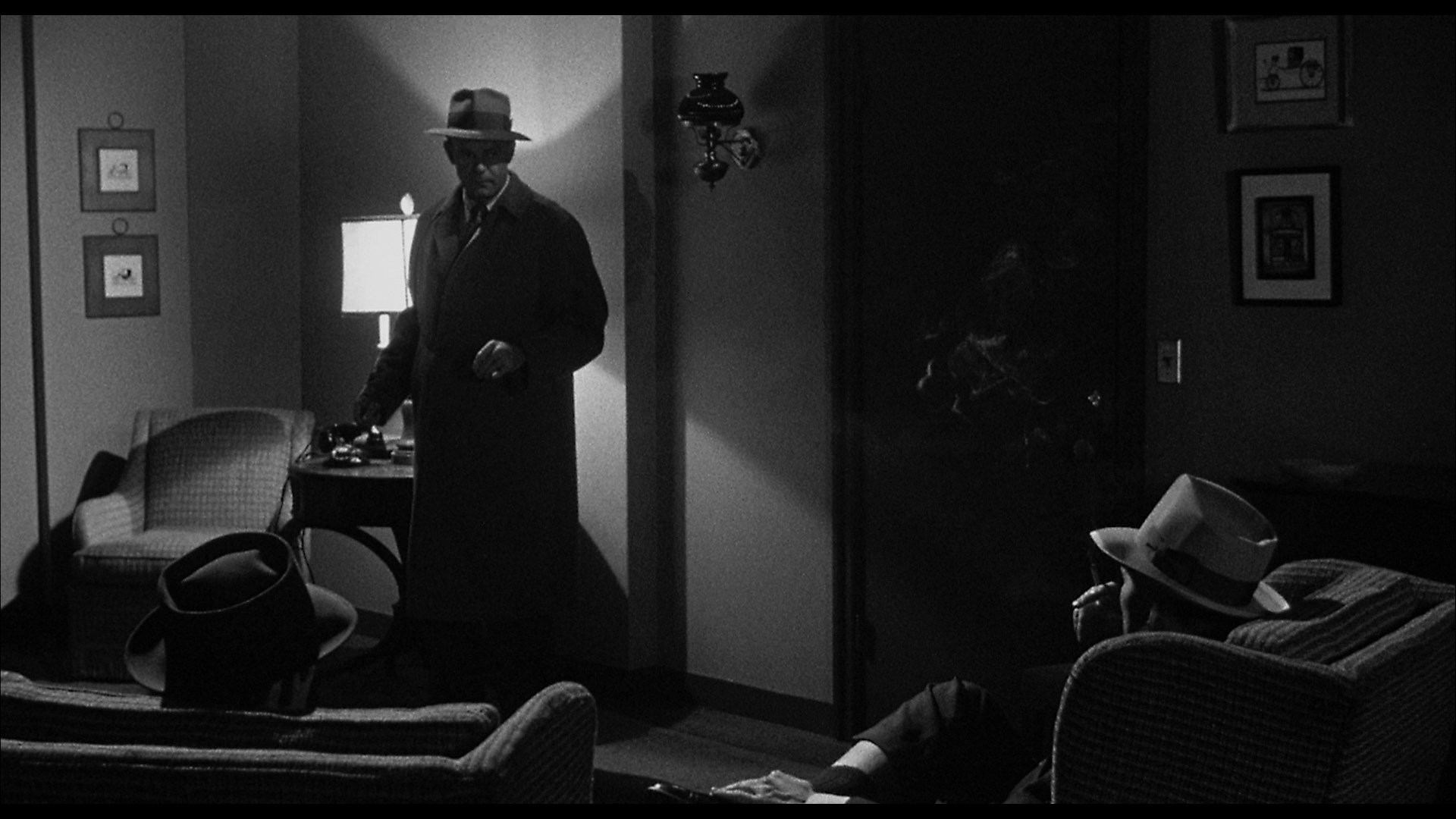 legit release until this Blu-ray edition. This is really the first opportunity in several decades to see it in pristine condition, and it's a real treat here to put it mildly. Film historian Toby Roan contributes a packed audio commentary with plenty of info about the personnel in front of and behind the camera, focusing on the many B-movie connections here and putting this in context with the later noir phase when its conventions were being diffused each year over the course of the decade. Also included are a 29-image gallery and 1940's From Nurse to Worse (16m47s), with the troublesome trio being approached by an insurance scammer to make some easy money ("$500 a month!) if Curly pretends to be a dog. You can imagine how well that goes.
legit release until this Blu-ray edition. This is really the first opportunity in several decades to see it in pristine condition, and it's a real treat here to put it mildly. Film historian Toby Roan contributes a packed audio commentary with plenty of info about the personnel in front of and behind the camera, focusing on the many B-movie connections here and putting this in context with the later noir phase when its conventions were being diffused each year over the course of the decade. Also included are a 29-image gallery and 1940's From Nurse to Worse (16m47s), with the troublesome trio being approached by an insurance scammer to make some easy money ("$500 a month!) if Curly pretends to be a dog. You can imagine how well that goes.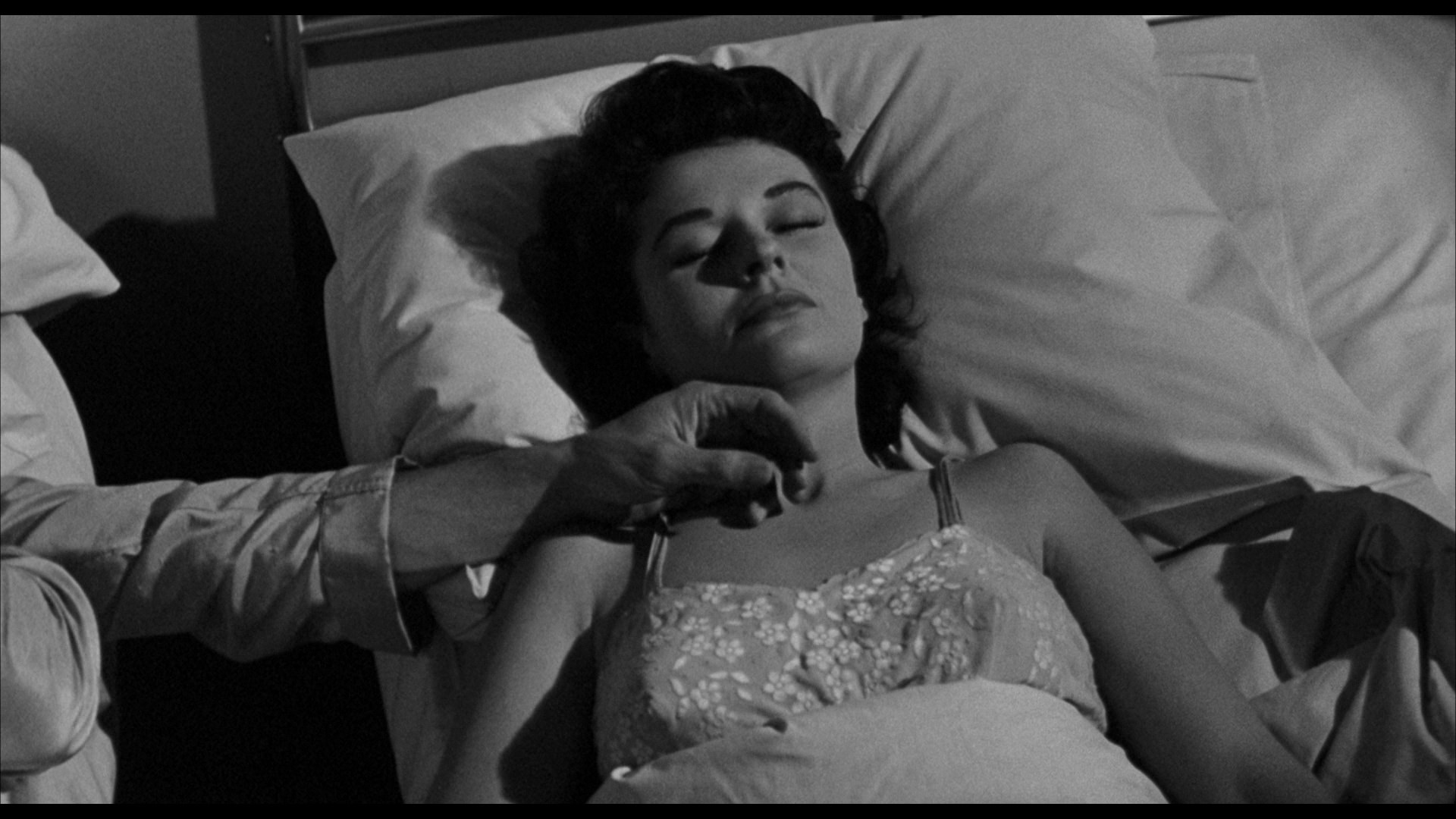 discoveries (along with The Sniper and Murder by Contract) when Sony and
discoveries (along with The Sniper and Murder by Contract) when Sony and  Martin Scorsese were rolling these out on DVD and limited repertory theatrical play back in the '00s. One of the all-time great hardboiled directors, Phil Karlson, helms this gritty family drama about a onetime mob bookkeeper, Eddie Rico (Conte), who's now happily married to Alice (Foster) in Florida and running a laundry business. Apart from unsuccessful attempts to have children, they seem to have it all together until he's called on to give a temporary roof to an old associate. Things get worse when his two connected brothers, Johnny (Darren) and Gino (Picerni), go AWOL, only for Gino to turn up with a staged fender bender to reveal that the life has finally caught up to him so badly he plans to flee to Cuba. Needless to say, it isn't long before Eddie has to find out for sure whether blood is really thicker than water as it turns out Johnny is on the mob's current hit list and all of their options could be limited.
Martin Scorsese were rolling these out on DVD and limited repertory theatrical play back in the '00s. One of the all-time great hardboiled directors, Phil Karlson, helms this gritty family drama about a onetime mob bookkeeper, Eddie Rico (Conte), who's now happily married to Alice (Foster) in Florida and running a laundry business. Apart from unsuccessful attempts to have children, they seem to have it all together until he's called on to give a temporary roof to an old associate. Things get worse when his two connected brothers, Johnny (Darren) and Gino (Picerni), go AWOL, only for Gino to turn up with a staged fender bender to reveal that the life has finally caught up to him so badly he plans to flee to Cuba. Needless to say, it isn't long before Eddie has to find out for sure whether blood is really thicker than water as it turns out Johnny is on the mob's current hit list and all of their options could be limited.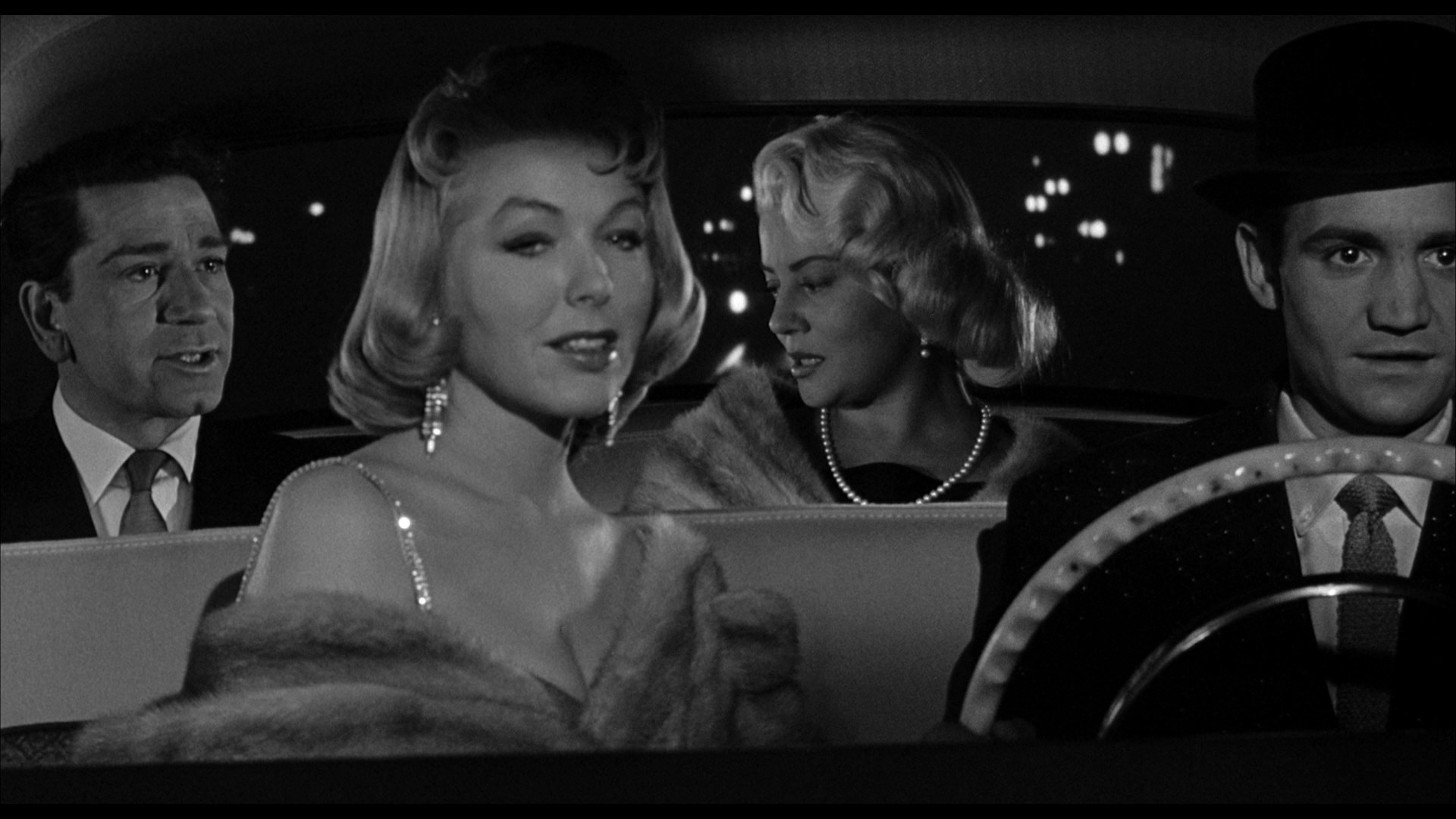 bit of Code interference (or test audience response), but otherwise this is a real high point in the '50s Columbia noir cycle and a justifiably popular cult title now. The
bit of Code interference (or test audience response), but otherwise this is a real high point in the '50s Columbia noir cycle and a justifiably popular cult title now. The 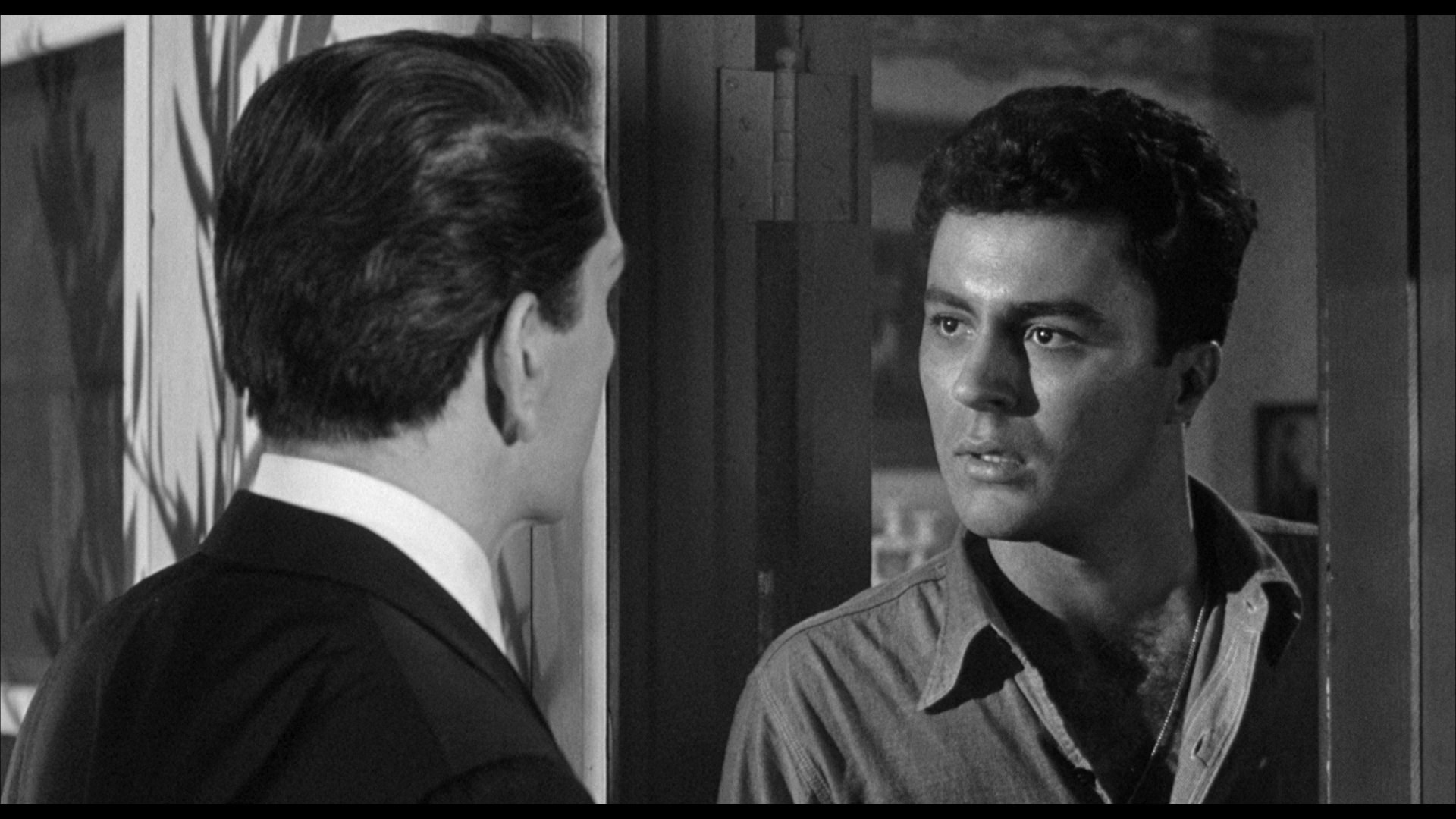 2010 DVD release has been out of circulation for a very long time, so it's very gratifying to have it back here in tip-top shape to win over new viewers. A new audio commentary by film scholar Jason A. Ney is a great accompaniment as he balances production info with some excellent insights into the story's themes, including an early personal connection to one plot point. Ported over from the original DVD is a short video intro by Scorsese (3m31s) praising the film's willingness to tread into uncomfortable emotional territory, followed by an in-depth look at Karlson in "A Bracing Brutality" (29m54s) with film critic Nick Pinkerton analyzing the filmmaker's life and career, both of which have been relatively neglected by film scholars over the years despite a number of major hits (including Walking Tall). A 36-image gallery compiles the usual assortment of promotional photos and other ephemera, while the theatrical trailer plays up the Simenon connection to the hilt. Finally, 1957's A Merry Mix-Up (15m55s) features the Stooges (Moe, Larry, and Joe in this case) as nine brothers -- three sets of triplets! -- whose lives suddenly collide with numerous romantic complications. How Indicator has managed to find thematically relevant Stooges shorts for every single one of these films to this point is truly a miraculous feat by this point! As usual, the limited edition box (6,000) units comes with a hefty 120-book featuring new essays by Beth Ann Gallagher, Bob Herzberg, Sophie Monks Kaufman, Omar Ahmed, Jen Johans, Monica Castillo, and Jeff Billington, plus archival articles and interviews.
2010 DVD release has been out of circulation for a very long time, so it's very gratifying to have it back here in tip-top shape to win over new viewers. A new audio commentary by film scholar Jason A. Ney is a great accompaniment as he balances production info with some excellent insights into the story's themes, including an early personal connection to one plot point. Ported over from the original DVD is a short video intro by Scorsese (3m31s) praising the film's willingness to tread into uncomfortable emotional territory, followed by an in-depth look at Karlson in "A Bracing Brutality" (29m54s) with film critic Nick Pinkerton analyzing the filmmaker's life and career, both of which have been relatively neglected by film scholars over the years despite a number of major hits (including Walking Tall). A 36-image gallery compiles the usual assortment of promotional photos and other ephemera, while the theatrical trailer plays up the Simenon connection to the hilt. Finally, 1957's A Merry Mix-Up (15m55s) features the Stooges (Moe, Larry, and Joe in this case) as nine brothers -- three sets of triplets! -- whose lives suddenly collide with numerous romantic complications. How Indicator has managed to find thematically relevant Stooges shorts for every single one of these films to this point is truly a miraculous feat by this point! As usual, the limited edition box (6,000) units comes with a hefty 120-book featuring new essays by Beth Ann Gallagher, Bob Herzberg, Sophie Monks Kaufman, Omar Ahmed, Jen Johans, Monica Castillo, and Jeff Billington, plus archival articles and interviews.![]()